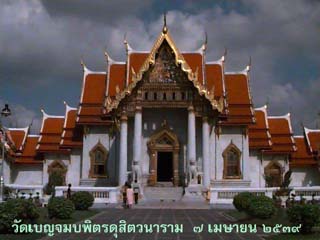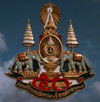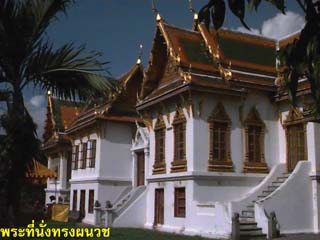
A Digital Camera Tour
By Thaweesak Koanantakool

All of the photographs shown in these web pages are declared public domain. I hereby donate these photos for anyone to make use of them. If any of you do, please make sure that you mention this web site in the re-publication. I would appreciate if you notify me of the usage. The story about the temple itself is partially taken from a booklet Wat Benchamabopit Dusitwanaram written by Phra SriwisuthiwongAll small photographs in this page are clickable and will lead you to the larger (high resolution) version of the same photographs. Higher resolution of the image is available on request., Deputy Abbot of the temple (publisher: Khurusapha Commercial Organization, ISBN 974-00-3718-5, B.E.2530:1993).
 The Golden Jubilee Symbol above the temple wall.
The Golden Jubilee Symbol above the temple wall.
This sign is about 1.3 meters high. All over Thailand in 1996, people will decorate their buildings with this sign to celebrate His Majesty the King's Golden Jubilee. This particular one is among the finest and largest sign I have ever seen. With Adobe Photoshop, I have removed the temple's wall and the supporters of the sign.
 It is a fine Sunday morning with no traffic jam and blue sky. When I walk through the main gate,
the first view that I saw is this famous main facade of the Ordination Hall (Phra Ubosoth) of the
temple.
It is a fine Sunday morning with no traffic jam and blue sky. When I walk through the main gate,
the first view that I saw is this famous main facade of the Ordination Hall (Phra Ubosoth) of the
temple.
The temple is located on Nakhon Pathom Road, by the Prem Prachakorn Canal. It is at the center among four other important spots of Thailand's capital: Dusit Palace, Ananta Samakom Throne Hall, and the Government House.
The Marble Temple is classified as a top-ranked royal temple, with the ordination hall being founded by His Majesty the King Rama V on March 1st, BE 2442 (AD 1899). Its rectangular landmark covers 220m (North-South) and 199m (East-West). Total area is approx. 42,264 sq.meter.
Prior to King Rama V's renovation of the temple, little was known about the temple, as it was probably not a famous tample. The temple's was called "Wat Laem" or "Wat Sai Thong" (Golden Sai Tree). When King Rama V built Dusit Palace, two temples (Wat Dusit and Wat Rang) were in fact dissolved for land reclaimation. The renovation of Wat Benchamabopit in a great way was also considered a compensation for two other temples.
His Majesty King Rama V established the Marble Temple with the following
objectives:

 Somdet Chaofa Khromphraya Narisaranuwattiwong;
Somdet Chaofa Khromphraya Narisaranuwattiwong;
I walk around the temple from the Ordination Hall through the South entrance into the Wiharn Kod, where more than fifty full-sized buddha statues in bronze and other metals are on display. Each statue shows Lord Buddha in various gestures from various eras of the past. Three fine corridors and the back of the ordination hall makes a clean and tranquil quadrangle, fully covered by marble slabs.
Normally, only the South entrance is opened for entry to and exit from Wiharn Kod. The North entrance is normally closed. I took the photographs of these two entrances so that you can see how the doors were carved, painted and opened. Someone might want to experiment with Java browser to animate the opening doors...
 In the picture, a group of sammanen (novices or little monks) walk into
Wiharn Kod
just about the same time that I do.
In the picture, a group of sammanen (novices or little monks) walk into
Wiharn Kod
just about the same time that I do.
Sammanen and monks entered the
 ordination ceremony normally held inside the ordination hall. Today, such ceremony is taking
place inside the hall. In the picture, the new monk is being "interviewed" by a group of monks led
by the abbot. Presiding over the whole ceremony is the Lord Buddha's statue "Phra Buddha Chinnarat"
at the background. Relatives and friends of the newly ordained monk are presence in the ceremony.
ordination ceremony normally held inside the ordination hall. Today, such ceremony is taking
place inside the hall. In the picture, the new monk is being "interviewed" by a group of monks led
by the abbot. Presiding over the whole ceremony is the Lord Buddha's statue "Phra Buddha Chinnarat"
at the background. Relatives and friends of the newly ordained monk are presence in the ceremony.
After Winharn Kod, I then walk to the small canal within the temple ground. The canal has a function of separating the "Buddha" area from the "Sangkha" area. It was constructed in BE 2442 (AD 1889) by the order of H.M.King Rama V. Technically, the earth taken from the canal was used to make the lands within the temple flat. Another function of the canal is to allow visitors to make merit by releasing fish and turtles into the canal. At all time, the canal is full of water animals.
 There is a small shelter (Sala) by the canal called
Sala Nam Thao Worachan. It is a nice place to sit down, especially
when the weather is very hot. I see a well-maintained garden around the sala, with plenty of
flowers. If you look at the photograph carefully, you can see someone taking a good nap
inside the shelter.
There is a small shelter (Sala) by the canal called
Sala Nam Thao Worachan. It is a nice place to sit down, especially
when the weather is very hot. I see a well-maintained garden around the sala, with plenty of
flowers. If you look at the photograph carefully, you can see someone taking a good nap
inside the shelter.
 Well, you cannot see his face. Click the little picture on the left to see what
I mean.
Well, you cannot see his face. Click the little picture on the left to see what
I mean.
By the Sala there is a small red bridge called Sapan Thouy(Cup Bridge) crossing the small canal. Two sammanen were looking at the other bridge down the canal. I am crossing the bridge to the other side, the Sangkha area.
 The first building near to the bridge is another sala with four gables, containing some large
drums. The name of this sala is
Sala Si Somdet, meaning that the sala was
built by four royalties. The symbolic shields of the owners of the sala are placed right at the
four facade of the gables.
The first building near to the bridge is another sala with four gables, containing some large
drums. The name of this sala is
Sala Si Somdet, meaning that the sala was
built by four royalties. The symbolic shields of the owners of the sala are placed right at the
four facade of the gables.
 Next to Sala Si Somdet is a group of four beautiful buildings. They are called
Phra Thinang Song Phanuat. These two-storey buildings were originally
built at the Temple of the Emerald Buddha. When King Rama V went into monkhood at the temple,
in BE 2416 (AD 1873),
he practiced buddhism and resided in the buildings. Six years later, the King decided to relocate
the buildings from the Temple of the Emerald Buddha (with the exception of the Ordination Hall),
to Wat Benchamabopit.
Next to Sala Si Somdet is a group of four beautiful buildings. They are called
Phra Thinang Song Phanuat. These two-storey buildings were originally
built at the Temple of the Emerald Buddha. When King Rama V went into monkhood at the temple,
in BE 2416 (AD 1873),
he practiced buddhism and resided in the buildings. Six years later, the King decided to relocate
the buildings from the Temple of the Emerald Buddha (with the exception of the Ordination Hall),
to Wat Benchamabopit.
The whole set of buildings were relocated with little modifications and small extension. After the completion of the construction work, King Rama V ordered the buildings to be the official residence of the abbot of the Wat. The first abbot, Somdet Phra Wannarat, stayed here.
At present, the building is part of the National Museum. The permanent exhibition inside the buildings include the bed used by King Rama V while being ordained. The exhibit also include twenty paintings and murals on King Rama V. These murals depicted the activities of King Rama V, historic events and on Thai culture.
We can spend a few more hours at the temple, looking at the splendid architectures, Thai paintings, Carving and stained glasses inside the Ordination Hall. There are twenty more buildings that one can see in the temple. You may join long-term history lessons by studying the Buddha images here. The short introduction to the temple via the cyberspace is now over. I wish you can come to Thailand and visit the real temple one day.If this is not exciting enough, only 50 meters from the temple, you can visit the "protesters' camp" where hundreds of poor Thai people from the Northeast came to convey some messages to our prime minister, Banharn Silpa-archa.
All photographs were taken using Apple QuickCam 150 in high
resolution mode.
These digital photographs are best viewed in 16 million colour mode.
Severe degradation is noticable
if you are viewing these pages on a low-end 256-colour display system.
Comments and responses to Thaweesak Koanantakool